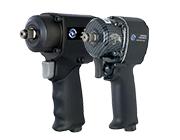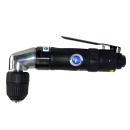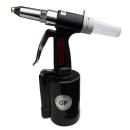Bodywork drilling

Car body drilling and riveting machine
︾
Discover our professional bodywork drilling tools:
Reversible composite drill :
The reversible composite drill is a versatile tool designed to deliver optimum performance in a variety of applications. Here are some of its key technical features:
Reversibility : The reversible function allows the drill to operate in both forward and reverse, offering greater flexibility when drilling and screwing.
Adjustable power: The ability to adjust speed and torque allows the user to adapt the drill to different materials and applications, offering precise control.
Keyless chuck: Fitted with a keyless chuck, the drill makes changing bits quick and easy without the need for a spanner.
Ergonomic design: An ergonomic handle and balanced weight make for a comfortable grip, reducing user fatigue during prolonged use.
Integrated lighting: Some models feature integrated LED lighting, improving visibility in poorly lit work areas.
Angle drill :
The angle drill is specially designed to access tight spaces and drill at difficult angles. Technical features include:
Swivel head : The head of the angle drill can swivel, offering great flexibility for reaching hard-to-reach areas.
Adjustable power: Like the composite drill, it generally offers adjustable power to suit different applications.
Self-tightening chuck: Some models are equipped with a self-tightening chuck, simplifying the process of changing drills.
Side handle: A side handle offers better control when using in awkward positions.
Riveter:
The riveter is an essential tool for setting rivets in a variety of materials. Technical specifications include :
Clamping force : Measured in kilograms or newtons, the clamping force determines the riveter's ability to clamp rivets effectively.
Rivet size: Riveters can be adapted to different rivet sizes. Make sure the tool is compatible with the rivet size required for your project.
Compatible materials : Some riveters are specifically designed to work with materials such as metal, plastic or leather. Check compatibility with the material you plan to rivet.
Quick-release trigger: A quick-release trigger facilitates continuous use of the tool without the need for prolonged pressure.
These technical features provide an overview of the performance and functionality of these tools, enabling users to choose the one that best meets their specific needs for drilling, screwing or rivet setting.
The differences between pneumatic drills and pneumatic riveters :
The pneumatic drill and the pneumatic riveter are two different tools, designed for distinct tasks in the field of fastening and assembly. Here are some of the main differences between these two pneumatic tools:
1. Main function :
Pneumatic drill: Designed to drill holes in a variety of materials, such as wood, metal or plastic. It is used to create openings for screws, bolts or other fasteners.
Pneumatic riveter: Its main purpose is to set rivets in materials, usually metal. It compresses the rivet to create a strong, permanent bond between the parts.
2. Tool action :
Pneumatic drill: It uses a rotary motion to rotate the drill bit, creating a hole in the material.
Pneumatic Riveter: Uses a compression action to set the rivet by compressing the rivet ends together.
3. Accessories :
Pneumatic drill: This is usually fitted with a chuck that can hold different types of drill bits depending on drilling requirements.
Pneumatic riveter: Uses specific bits for each rivet size.
4. Common uses :
Pneumatic drill: Used in a variety of applications, from joinery to metal fabrication, to create precise holes.
Pneumatic Rivet Driver: Commonly used in the assembly of metal structures, car bodies and other applications where rivets are required for fastening.
5. Types of pressure :
Pneumatic drill: Requires air pressure to power its motor and drive the rotary motion.
Pneumatic riveters: Also use air pressure to exert the force required to set rivets.
6. Tool configuration :
Pneumatic drill: This has a more elongated configuration, with a chuck at the end where the drill bit is inserted.
Pneumatic riveter: This can be a more compact configuration, with a specially designed head for holding and compressing rivets.
In summary, although both pneumatic drills and pneumatic riveters work with compressed air, they have different applications and mechanisms to meet specific fastening and assembly needs in various industrial sectors.
FAQ on using pneumatic tools for your bodywork drilling operations :
When it comes to using pneumatic tools for bodywork drilling, many questions arise about efficiency, safety and the choice of appropriate tools. Let's take a professional look at some of these commonly asked questions.
What's the difference between a pneumatic drill and an electric drill for bodywork drilling?
Pneumatic drills use compressed air to generate power, whereas electric drills run on electricity. Pneumatic drills are often lighter, offer constant torque and are ideal for applications requiring prolonged handling.
How do I choose the right drill size for bodywork drilling?
The size of drill bit depends on the type of drilling you are doing. For screw holes, choose a drill bit slightly smaller than the diameter of the screw. Make sure the drill bit is suitable for the bodywork material (metal, plastic, etc.).
What air pressure is recommended for a pneumatic drill when drilling bodywork?
Consult the drill manufacturer's specifications to determine the recommended air pressure. In general, maintaining a constant pressure of between 90 and 100 psi (pounds per square inch) is common for many bodywork drilling applications.
How can I avoid splinters or tears when drilling fragile materials?
Use an appropriate drill bit for the material, adjust the speed of the drill and make sure you apply moderate and constant pressure. Maintaining the right speed will minimise the risk of splintering.
What are the advantages of a pneumatic angle drill for bodywork drilling in hard-to-reach areas?
Pneumatic angle drills are ideal for accessing restricted areas. Their pivoting head makes them easier to manoeuvre without compromising power. This makes them a wise choice for precise work in difficult corners.
How do I maintain and care for a pneumatic drill to ensure it lasts?
Lubricate the tool regularly with pneumatic oil, follow the manufacturer's recommendations for maintenance intervals, and make sure the compressed air is clean and free of moisture to avoid internal damage.
In short, a thorough understanding of the tool's specification, the correct selection of accessories and regular maintenance are essential to get the most out of pneumatic tools when drilling bodywork, ensuring professional, long-lasting results.

